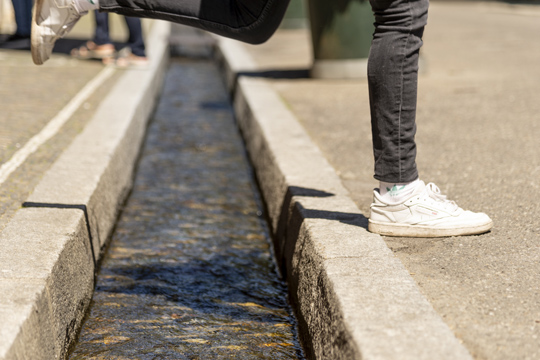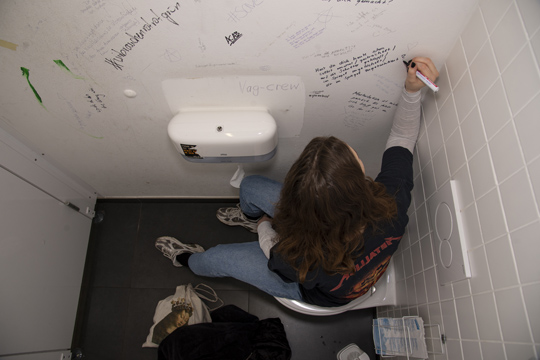Freiburg sings to a different tune too
Freiburg, Oct 09, 2020
What makes Freiburg special? It was the question University of Freiburg masters’ students posted on the occasion of the 900th anniversary of the city. Under the direction of the cultural anthropologist Dr. Sarah May, they wrote numerous essays on various forms of everyday life in the teaching project “Alltag findet Stadt” (Everyday Life meets the City). The students published their results in an illustrated book.
 Once part of a hygienic concept, Freiburg’s brooks today serve as an idyllic advertising motif in city marketing. Picture: Finn Hagen
Once part of a hygienic concept, Freiburg’s brooks today serve as an idyllic advertising motif in city marketing. Picture: Finn Hagen
Be it transient doodles on a restroom wall, the splashing of Freiburg's old town brooks or an Instagram post from the Blue Bridge at the main train station. For the empirical cultural scientist Sarah May, culture is “what structures everyday life and at the same time what we produce through our actions and ways of thinking.” Her concept of culture is by no means limited to high and popular culture. In the teaching project “Alltag findet Stadt” (“Everyday Life meets the City”), May and eight Master’ students from the Institute of Cultural Anthropology and European Ethnology investigated how people in Freiburg perceive their everyday life and how it is translated into routines and practices. Planned as part of the festivities for Freiburg’s city anniversary in 2020, the project began in the 2019 winter semester and was based, for example, on the exhibition “WarteArt” (“The Art of Waiting”) on activities and perceptions while waiting and the illustrated book Platz da! (Sit!), which documents how Freiburg’s citizens perceive their growing city. May received the 2018 University Teaching Award from the University of Freiburg for such research-oriented teaching projects.
Written and illustrative essays
“We were interested in researching the specifics of Freiburg,” said May. “What makes the city so special right now?” The students made observations, conducted interviews, did archival research, and wrote a total of 17 essays, whose topics they selected themselves. Most of them contributed two texts each; May wrote the introductory text and the essay “können” (“we can”). The project team collected and illustrated all essays in a large-format text and picture book, which is also addressed to a non-academic readership.
In order to prepare their research results for the public, the students received professional support. They first thought about how they could communicate the specifics of life situations through words, but also through images. The photographer Finn Hagen captured the research fields in pictures. The Freiburg graphic artist Sonja Koskowski designed the layout for the volume. The University Media Centre supported the team in creating a video series on Instagram, which is also part of the project. However, most of the work - such as creating the illustrated book and the video series and taking care of the finances - was done by the students themselves. “I guided the process and asked critical questions. It was particularly important to me that the work the team did was based on equal footing and performed independently,” May explains.
 The toilet wall as a mood barometer: In the form of scribbles, toilet guests share even the most intimate thoughts with the public. Picture: Finn Hagen
The toilet wall as a mood barometer: In the form of scribbles, toilet guests share even the most intimate thoughts with the public. Picture: Finn Hagen
The city as both inherent logic and a dynamic process
The theoretical basis for the students’ work was the sociological concept of inherent logic, which was coined by the sociologist Pierre Bourdieu. It assumes that every city has its own unmistakable and individual character and that each city has its own specific actions and interpretations. Applied to the work on the project, it means that “every city, including Freiburg, sings to a different tune, has its own rhythm and principles. What comes across as everyday wisdom can be exaggerated to the extent that the logic of a city functions as a structure, a kind of backbone from which the actions of its inhabitants intuitively take place.”
Another basic assumption of the project - the city is not static, but a dynamic process - is clarified by Marlene Diemb in her essay “fließen” (“flow”). It addresses the city’s brooks and their change in meaning. For example, the network of rivulets that runs through the city center once served hygienic purposes, while today it is part of the city marketing as an idyllic advertising motif. Karlin Schumacher shows in her essay “ankommen” (“arriving”) that appropriation and reorientation in the city is also a process for new citizens. “In order to understand where I actually was, I went by foot. Then you could see more and I was better able to find my bearings,” says student Maria Aunen, who was in Freiburg during an Erasmus stay.
Of restroom walls and social media
Leonie Hagen summarizes her field research on the poetry of restroom sayings in the text “kritzeln” (“scribbling”). She considers the paradoxical communication form of such sayings, also called "restroom paradox" in research, in which the most intimate things are negotiated in public, among other things from the perspective of a "mood barometer". In her essay, Lea Breitsprecher examines what happens when a motif from Freiburg is posted on social media. According to Breitsprecher, the answer can be summed up in a short formula. The urban space expands into virtual space. According to Breitsprecher, Freiburg no longer consists solely of the city's houses and streets, but also of images, stories, notes, comments and evaluations.
“The stakeholders’ perceptions shape the city. In cultural anthropology, we assume that something like a city does not simply exist, but is a construct that is created,” Breitsprecher explains. It also points out that different people perceive and evaluate objects, processes or actions differently. “In principle, this is what we want to achieve with our project. We present different stakeholders with their different views of the city and thus show the diversity that can exist, the ambiguities that arise. Freiburg does not exist in a vacuum. The city is then brought into existence by the many different perspectives people have.”
Hans-Dieter Fronz
Website for “Alltag findet Stadt”
Picture book Alltag findet Stadt

